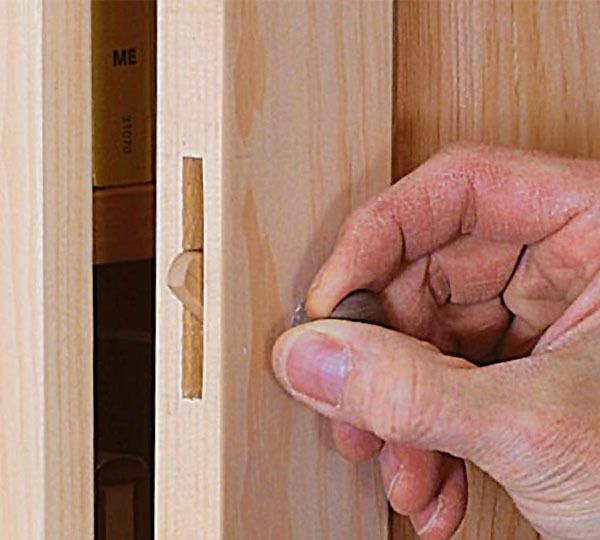
Synopsis: Four woodworkers share solutions for keeping doors shut with handmade hardware. All of them look better than most store-bought products, and they can be customized to fit your needs. Each technique eliminates the need for clunky hardware in your cabinet. These favored options include rare-earth hidden magnets, Shaker spinners, flipper catches, and button catches. Each author explains in detail how to build his particular catch.
To keep cabinet doors closed, I often rely on the magnetic attraction of rare-earth magnets, which provide a clean, hardwarefree look.
Instead of placing the magnets so that they make contact when the door is shut, I glue them in the top and bottom of the door and the case, leaving them a fraction of an inch apart. The magnets gently pull the door flush to the case once it swings closed—a satisfying effect, especially if the door has been fitted to close tolerances. I cover the magnets with wood plugs. Keep in mind that this technique works only with free-swinging doors. Avoid selfclosing or other spring-loaded hinges.
Investigate your magnets
Rare-earth magnets are my preferred pullers. Ounce for ounce, these slim, 1 ⁄8-in.- thick discs pack more power than any other magnet I’ve seen.
Be sure to size the magnets so that they have the necessary pulling power. I used 3 ⁄8-in.-dia. magnets for the small jewelrybox door shown here. Larger 1 ⁄2-in.-dia. magnets work best for typical 3 ⁄4-in.-thick cabinet doors. With bigger doors you need bigger magnets.
Make mortises for the magnets
Drill the mortises for the magnets in the case pieces before assembling them. Offset the mortise in the base toward the rear, which will help pull the door closed. For my cabinet, I drilled 3 ⁄8-in.-dia. mortises in the case top and bottom. Regardless of the diameter of the magnets, make the mortises 1 ⁄4 in. deep to allow for the nominal 1 ⁄8-in.-thick magnets and the wood plugs that hide them. To make flat-bottomed mortises, use a Forstner bit.
Once you’ve drilled the mortises in the case parts, assemble the case, then build the door. Take your time getting a consistent door reveal. Once you’ve installed the magnets and covered them with plugs, you’ll have little room for adjustments. I aim for a reveal of about 1 ⁄32 in. so that the door slows on a cushion of air as it is shut, then is quietly drawn in by the magnets.
From Fine Woodworking #155
For the full article, download the PDF below:

















Log in or create an account to post a comment.
Sign up Log in